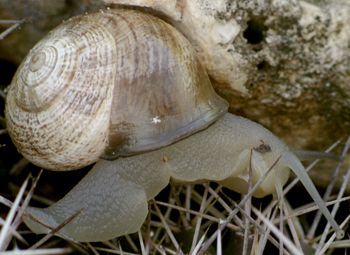
A Garden Snail gingerly glides over cactus thorns
Generally, land snails are among those easily overlooked aspects of the landscape that just don't seem very interesting. Their bleached shells litter the ground to the point of seeming to be part of the soil. In fact, there are some who believe that snail shells are the same as rocks. I had a friend in school that once decorated her science project aquarium showing "healthy, clean water" with empty shells. When I pointed out that they were dead and would be more appropriate in the "polluted, disgusting, industrial waste water," she replied with complete conviction that snail shells were NEVER part of a living creature and were just part of the minerals that make up our planet. Go figure.
 A Garden Snail gingerly glides over cactus thorns |
During wet periods, snails appear as if by magic. This is when gardeners get exasperated by the thousands of nibbling mouths that ruin tiny seedlings and are dismayed by the trails of slime left all over prized plants. When it gets dry again, the little creatures simply disappear. Aside from their pesty aspects, they are rarely given a second thought.
Mollusks are mostly aquatic, but those that flourish in terrestrial environments have some nifty adaptations. The foot (the large part that slides along on a film of slime) must be tough enough to deal with dry and sometimes spiky surfaces. The creatures also each need a lung to breathe. And they must be able to hole up within their shells to survive when it is too hot or arid. Obviously, from the large number of dead shells everywhere, many individuals die when conditions turn nasty. Some, however, must survive, or there wouldn't be well over a hundred species of land snails in Texas.
 a view of the respiratory pore under the edge of the mantle | 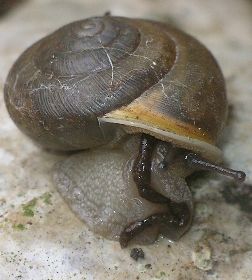 consequences of having the anus so close to the head |  eyes on stalks! |
Most of the guts of a snail are squeezed into the spiral shell it carries on its back. The breathing hole, as well as the anus, are located on the edge of the mantle where it joins the shell. The mantle secretes calcium carbonate to make the shell grow, and it covers all the internal organs. Slugs also have a mantle. It does not produce a shell, of course. Less evolved versions of these animals, like the Black Leather Slug common around here, have a mantle so large it covers the entire body. They also excrete the waste back near their tails, instead of towards their front like the more "advanced" slugs and snails. So, from my anthropomorphic view, who is to say which is actually more primitive?
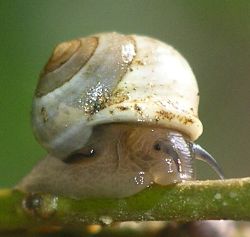 the adorable Globular Drop |
Speaking of primitive vs. advanced, there are some features that indicate evolutionary relationships among different kinds of snails. As I mentioned, slugs that poop out the back are more primitive than those that do so near their front. The primitive slugs also have eyes on tentacles that pull back into their bodies without going inside-out. By contrast, advanced snails and slugs pull their eye-tipped tentacles inside-out when they draw them in. We have a very common little snail called the Globular Drop. It really is cute, round, and button-like. It is also considered to be very primitive. It doesn't have eyes on the tips of its tentacles, but located on its head just below them. This endearing little mollusk has an interesting survival tool. It can sometimes be found with a very thick, reflected lip on the opening of its shell. Other individuals have a very thin lip. This variability is theorized to be due to the sequestering of calcium within the shell edge. When conditions are optimal, the animal stores excess calcium to be used for shell-building during leaner times.
As if their physical attributes weren't enough to attract the attention of curious naturalists, snails also have some odd behaviors. The only problem is that snails and slugs move so slowly that most people don't have the patience to watch them long enough to figure out what they are doing. And really, most of the time, land snails simply do not do anything more interesting than eating and excreting. When it rains hard, they must flee the flood or drown, so they can often be seen hightailing it for safe refuge. I have yet to perceive any difference in their speed at these times, but it may be like discerning the difference between 46 and 47 seconds.
One of the more noticeable snail activities, other than eating, is mating. Most land snails and slugs are hermaphrodites, which means they have both male and female parts. Mating between snails generally looks like a wrestling match (hmmmm, not so different from certain mammals) as each one tries to impregnate the other. From what I've seen, they usually succeed in a mutual way. While snails make a lot of body, or "foot," contact during mating, Black Leather Slugs prefer the "donut" position. Considering that these little beasts look like they are made from tire rubber that has been out in the sun too long, it is easy to imagine a miniature automobile wheel. As you can see from the accompanying photo, these slugs simply puncture each other anywhere they can reach.
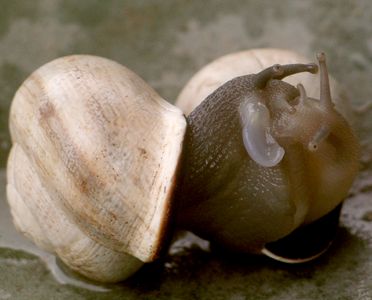 Garden Snails with one thing on their tiny minds | 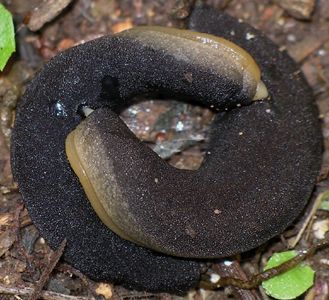 Black Leather Slugs making whoopee |
The diets of land snails and slugs includes just about everything remotely edible. Many species eat living plants, but others prefer scavenging dead tissue, fungi, or waste matter. Snails have an organ called the radula, covered with tiny chitinous teeth, which they use to rasp food, from bits of skin off a carcass to algae off the bark of trees. A few species of snails are carnivorous. Because snails are not the swiftest of animals, their prey is limited to things they can catch, and that includes other snails. Among our diverse terrestrial mollusk fauna, there are a couple of hunters, including the Rosy Wolf Snail and the Decollate Snail. This second species is so named because the last few whorls of its elongated shell characteristically break off, or decollate.
 snail attack! |
Once they hit the ground, the Decollate Snail spent the next 10 minutes attempting to penetrate the body of its prey while the latter tried to dislodge its attacker. During this time, my friend joined me to watch, so we had a nice chat to pass the time while waiting for some evidence of a change in the situation between the mollusks. Eventually, the sun came out from behind some clouds and, after another 5 minutes or so, it must have gotten too warm for the snails, as they both gradually moved toward cover. In doing so, the white snail climbed right up on the back of the predator and glided over it, neither one showing the slightest interest in the other. It seemed apparent that the change in conditions was life-threatening enough to the snails that their only possible reaction was to seek cover. Acquiring food or escaping an attacker were just not in their repertoire of currently appropriate behaviors. About as dramatic as watching mud dry.
While there will probably never be a National Geographic television special about the snails living in Austin gardens, they are still a curious part of the ecosystem, and unraveling their slimy mysteries can be rather fun, especially if one has time to relax and chill out at the proverbial snails' pace.